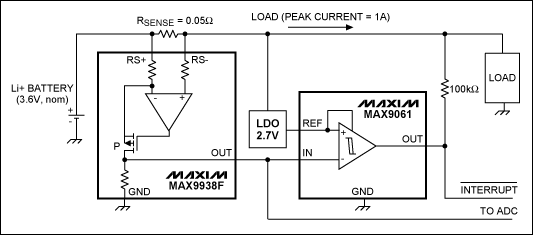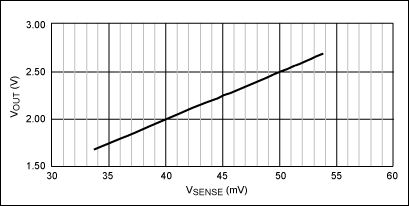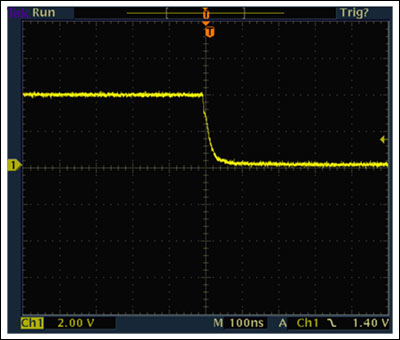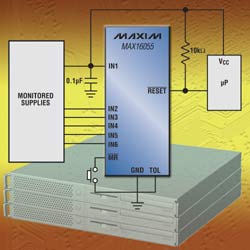This application note focuses on battery management in smartphones, cellular phones, and other portable devices. It describes how to solve the problems of estimating remaining battery life and implementing protection from battery overcurrent conditions with very simple, ultra-small and ultra-low-power devices such as a current-sense amplifier and a comparator.
This application note presents simple, space-saving methods for addressing two common features required by portable applications. First, it describes a highly accurate, ultra-low-power solution for estimating the remaining battery life. Then, it details a compact, power-saving solution for protecting the circuitry and Li+ battery from overcurrent conditions.
Figure 1 shows the MAX9938 current-sense amplifier. It features an ultra-low quiescent current consumption of less than 1µA (max) at ambient temperature (25°C) and is packaged in a tiny, 1mm x 1mm, 4-bump UCSP (ultra-chip-scale package). Chip scale is an IC packaging technology in which solder balls take the place of pins, allowing the smallest package available.¹ The low input-offset voltage of this current-sense amplifier ensures minimal voltage drop across the sense resistor, thus reducing the power dissipation of the resistor itself.
In a typical portable device such as a smartphone, the peak current in transmission mode can reach up to 1A. Assuming that the ADC full-scale is 2.5V, one can use a 50mΩ sense resistor with the MAX9938F, which has a fixed gain of 50. With these values, the maximum voltage across the sense resistor is 50mV and its maximum power dissipation is 50mW. With less than 500µV maximum input-offset voltage, the error due to such an offset is limited to less than 1% of the peak-current value.
If better accuracy is needed, one can use a 100mΩ sense resistor with the MAX9938T, which has fixed gain of 25. The offset error is reduced to 0.5% of the peak-current value; however, the power dissipation in the sense resistor is doubled.

Figure 1. The MAX9938F current-sense amplifier is used to measure battery current, while the MAX9061 comparator is used to detect an overcurrent condition.
A comparator such as the MAX9061 is ideal for implementing overcurrent protection in portable devices (Figure 1). The MAX9061 uses an innovative technology to self-power its internal circuitry from the reference voltage that is applied to its positive input, which can vary from 0.9V to 5.5V. The negative input can go as low as -0.3V and as high as 5.5V; it is independent from the reference voltage and, thus, can be higher. The output is open-drain and requires an external pullup resistor, which in many cases can be internal to the microcontroller. This unique and innovative architecture allows the comparator to fit in a four-terminal package such as an ultra-tiny, 1mm x 1mm, 4-bump UCSP.
As shown in Figure 1, the input of the MAX9061 is connected to the output of the current-sense amplifier, whose maximum voltage of 2.5V corresponds to the peak battery current. The reference can be connected to a low-dropout (LDO) linear regulator with a higher voltage such as 2.7V. When the input of the MAX9061 is higher than the reference, the comparator output is asserted low and an interrupt is generated.
Besides offering the advantage of a tiny package that can be as small as two 0402 resistors, the MAX9061 is an ultra-low-power device that consumes only 100nA (max) of bias current. The pullup resistor can be as high as one wants if the purpose is to minimize the current flowing through it, because the interrupt is generated on the falling edge of the comparator. The fall time is not dependent on the pullup resistor value. If a reversed output polarity is needed, use the MAX9060, which asserts the output low when the reference is higher than the input voltage.
Table 1. Input (VSENSE) and output (VOUT) measurements for the MAX9938F

Figure 2. The gain profile of the MAX9938F.
The voltage generator was then set higher than 4.5V to simulate an overcurrent condition of more than 1A. Figure 3 shows the response of the MAX9061, which generated the interrupt.

Figure 3. The high-low response of the MAX9061 to an overcurrent condition.
¹For more information on Maxim's UCSP packaging, refer to application note 1891, "Wafer-level packaging (WLP) and its applications."
Introduction
Smartphones, cellular phones, and other portable devices require increasingly smaller form factors and ultra-low power consumption. At the same time, the complexity and number of features in such equipment continues to increase. Consequently, the space available for each function is diminishing at an amazing rate.This application note presents simple, space-saving methods for addressing two common features required by portable applications. First, it describes a highly accurate, ultra-low-power solution for estimating the remaining battery life. Then, it details a compact, power-saving solution for protecting the circuitry and Li+ battery from overcurrent conditions.
Li+ battery-current monitoring
The remaining Li+ battery life can be estimated by accurately measuring the current that is constantly drawn by the load. A small sense resistor can be inserted between the Li+ battery and the load, and that produces a voltage that is proportional to the load current. A current-sense amplifier can then be used to sense this small voltage (typically several tens of mV) and to amplify it in order to produce an output voltage that fits within the dynamic range of an analog-to-digital converter (ADC). Such a converter is typically inside the RF chipset or power-management integrated circuit (PMIC). The current-sense amplifier should be as noninvasive as possible; therefore, two fundamental requirements are small size and low power consumption, both of which are very attractive features for portable device makers.Figure 1 shows the MAX9938 current-sense amplifier. It features an ultra-low quiescent current consumption of less than 1µA (max) at ambient temperature (25°C) and is packaged in a tiny, 1mm x 1mm, 4-bump UCSP (ultra-chip-scale package). Chip scale is an IC packaging technology in which solder balls take the place of pins, allowing the smallest package available.¹ The low input-offset voltage of this current-sense amplifier ensures minimal voltage drop across the sense resistor, thus reducing the power dissipation of the resistor itself.
In a typical portable device such as a smartphone, the peak current in transmission mode can reach up to 1A. Assuming that the ADC full-scale is 2.5V, one can use a 50mΩ sense resistor with the MAX9938F, which has a fixed gain of 50. With these values, the maximum voltage across the sense resistor is 50mV and its maximum power dissipation is 50mW. With less than 500µV maximum input-offset voltage, the error due to such an offset is limited to less than 1% of the peak-current value.
If better accuracy is needed, one can use a 100mΩ sense resistor with the MAX9938T, which has fixed gain of 25. The offset error is reduced to 0.5% of the peak-current value; however, the power dissipation in the sense resistor is doubled.

Figure 1. The MAX9938F current-sense amplifier is used to measure battery current, while the MAX9061 comparator is used to detect an overcurrent condition.
Overcurrent protection
Overcurrent conditions can occur due to faulty components in the circuitry, or sometimes when too many software applications are switched on concurrently. Whatever the reason, such abnormal conditions must be immediately communicated to the central processor in the form of an interrupt.A comparator such as the MAX9061 is ideal for implementing overcurrent protection in portable devices (Figure 1). The MAX9061 uses an innovative technology to self-power its internal circuitry from the reference voltage that is applied to its positive input, which can vary from 0.9V to 5.5V. The negative input can go as low as -0.3V and as high as 5.5V; it is independent from the reference voltage and, thus, can be higher. The output is open-drain and requires an external pullup resistor, which in many cases can be internal to the microcontroller. This unique and innovative architecture allows the comparator to fit in a four-terminal package such as an ultra-tiny, 1mm x 1mm, 4-bump UCSP.
As shown in Figure 1, the input of the MAX9061 is connected to the output of the current-sense amplifier, whose maximum voltage of 2.5V corresponds to the peak battery current. The reference can be connected to a low-dropout (LDO) linear regulator with a higher voltage such as 2.7V. When the input of the MAX9061 is higher than the reference, the comparator output is asserted low and an interrupt is generated.
Besides offering the advantage of a tiny package that can be as small as two 0402 resistors, the MAX9061 is an ultra-low-power device that consumes only 100nA (max) of bias current. The pullup resistor can be as high as one wants if the purpose is to minimize the current flowing through it, because the interrupt is generated on the falling edge of the comparator. The fall time is not dependent on the pullup resistor value. If a reversed output polarity is needed, use the MAX9060, which asserts the output low when the reference is higher than the input voltage.
Circuit testing
The circuit of Figure 1 was tested with a voltage generator in place of the battery and with the assumption that the 4.2V maximum voltage of a fully charged Li+ battery produces a 1A current through the sense resistor and the load. The voltage generator was decreased all the way down to 2.8V, which represents the condition for battery end of life. Table 1 reports the measurements, and Figure 2 shows the gain profile of the MAX9938F. With a two-point measurement, the gain error was measured to be 0.21% for the particular device tested.Table 1. Input (VSENSE) and output (VOUT) measurements for the MAX9938F
| VBAT (V) | VSENSE (mV) | VOUT (V) |
| 4.5 | 53.777 | 2.6847 |
| 4.3 | 51.807 | 2.5865 |
| 4.2 | 50.639 | 2.5283 |
| 4.0 | 48.18 | 2.4054 |
| 3.8 | 45.674 | 2.2805 |
| 3.6 | 43.518 | 2.1728 |
| 3.4 | 41.142 | 2.0544 |
| 3.2 | 38.621 | 1.9285 |
| 3.0 | 35.997 | 1.7977 |
| 2.8 | 33.734 | 1.6847 |

Figure 2. The gain profile of the MAX9938F.
The voltage generator was then set higher than 4.5V to simulate an overcurrent condition of more than 1A. Figure 3 shows the response of the MAX9061, which generated the interrupt.

Figure 3. The high-low response of the MAX9061 to an overcurrent condition.
Conclusion
The shrinking enclosures of today's portable applications necessitate highly accurate, compact ICs. This application note has described how simple battery-management functions such as battery life estimation and overcurrent protection can be performed with noninvasive components such as ultra-low-power current-sense amplifiers and comparators packaged in tiny, 4-bump UCSP packages.¹For more information on Maxim's UCSP packaging, refer to application note 1891, "Wafer-level packaging (WLP) and its applications."
UCSP is a trademark of Maxim Integrated Products, Inc.
 电子发烧友App
电子发烧友App























评论